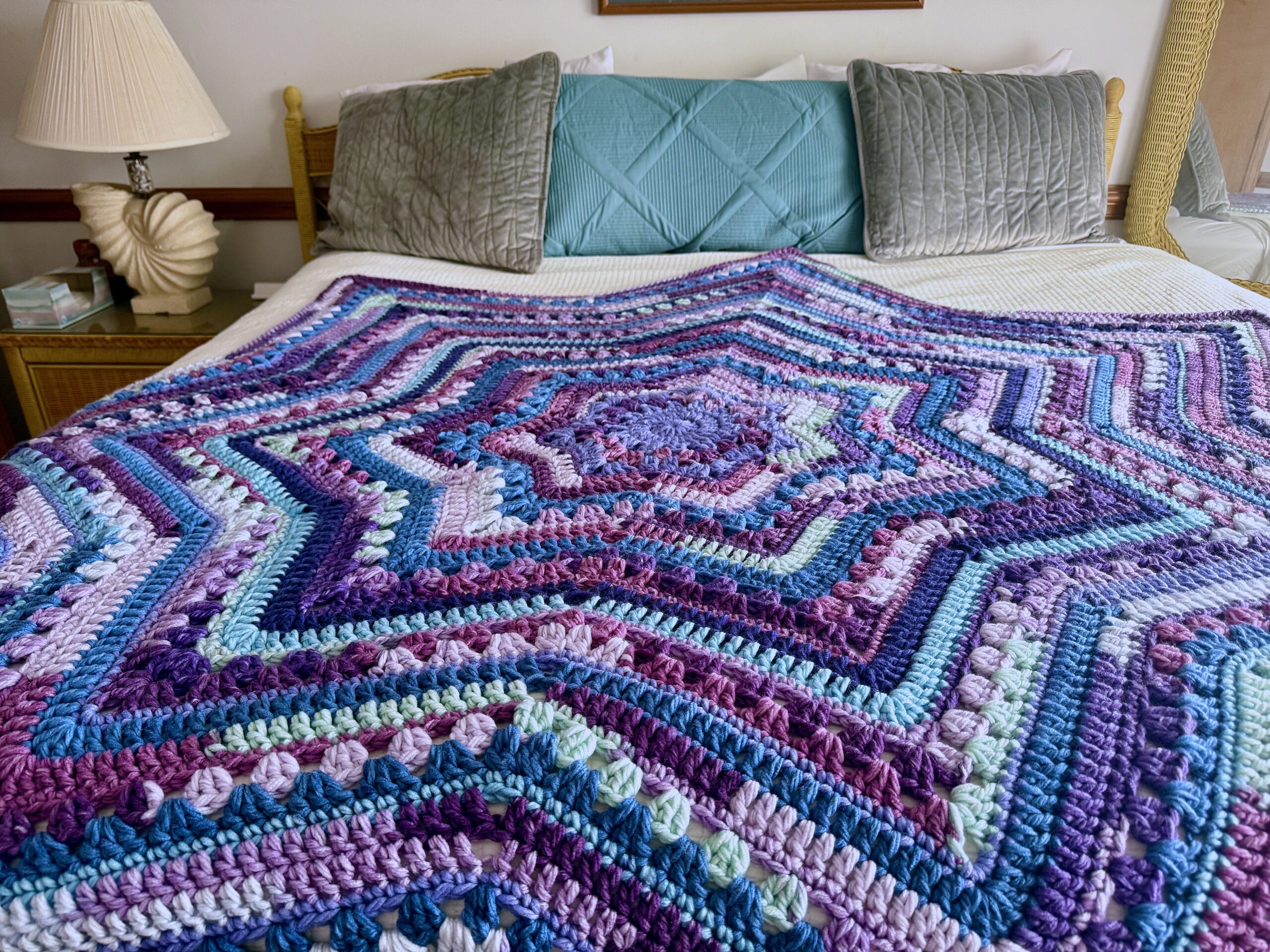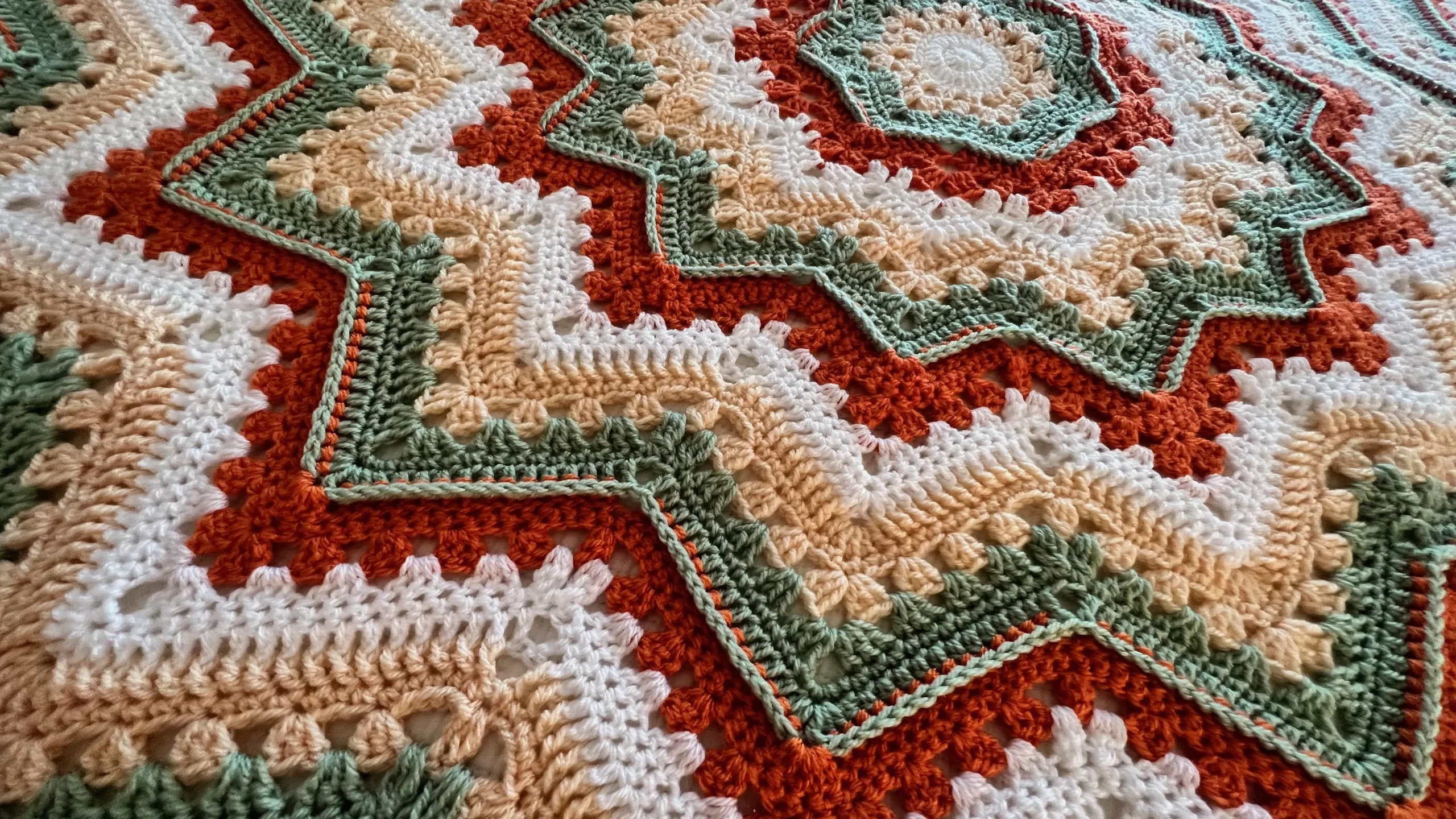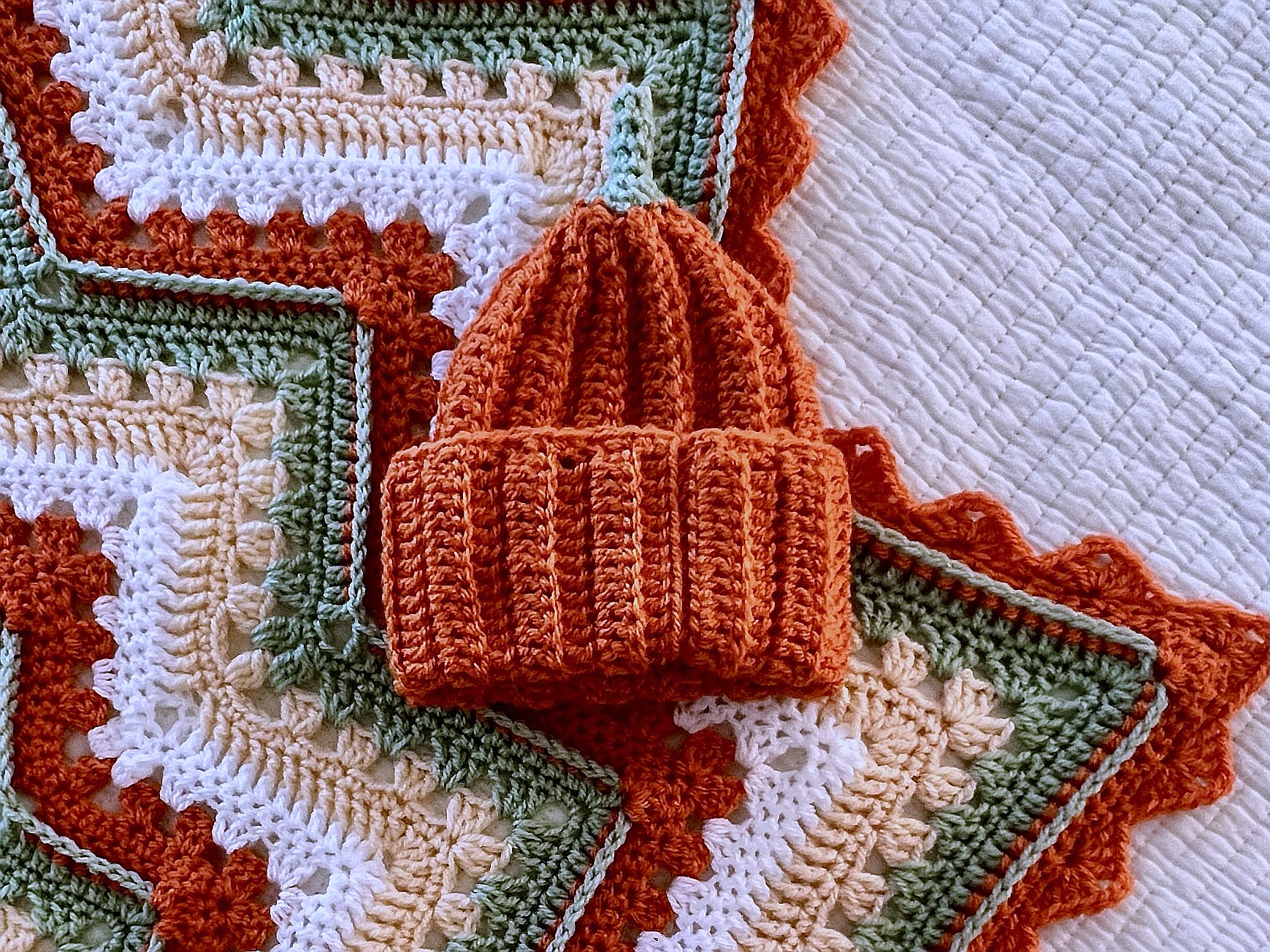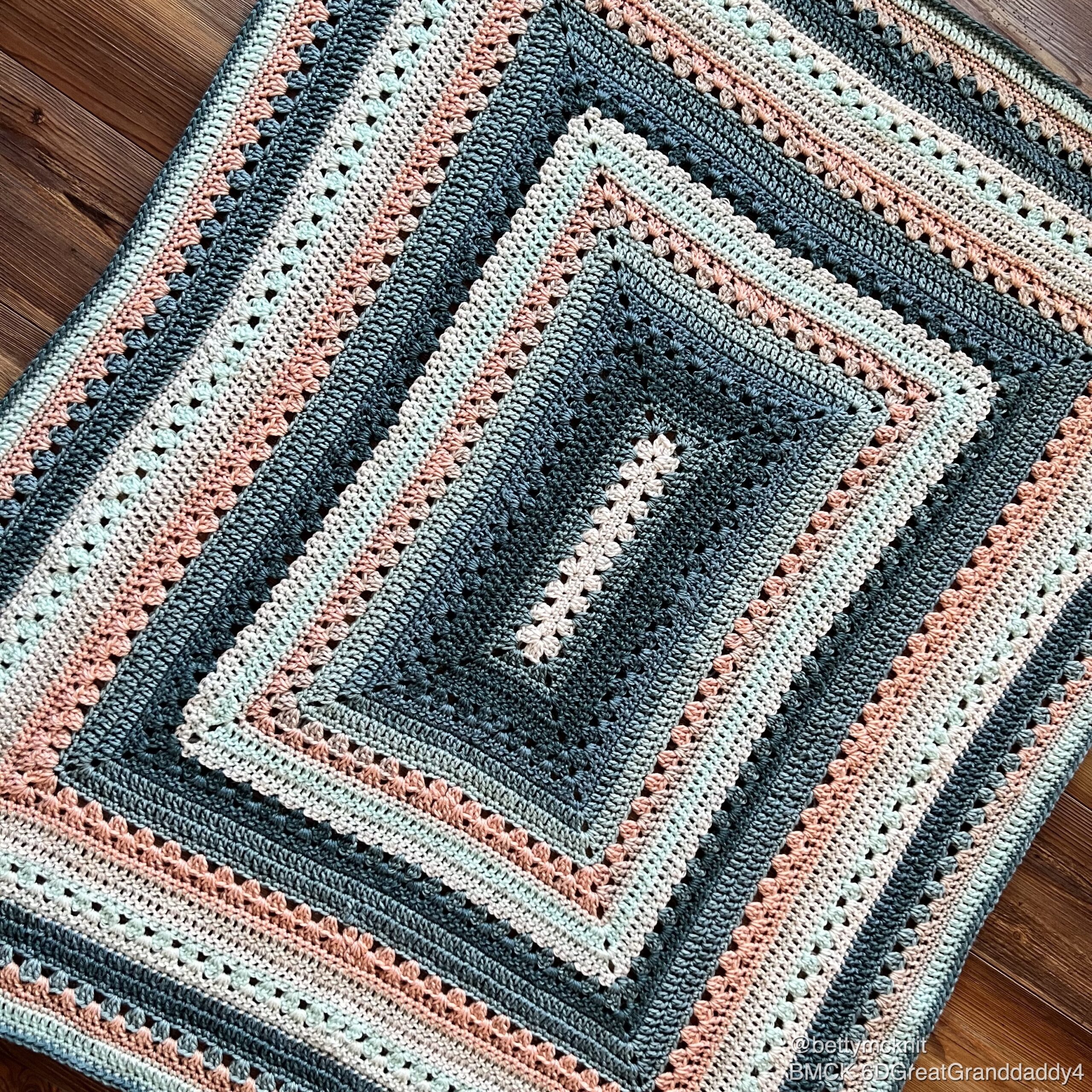6-Day Sweetheart Rainbow Baby Blanket
The 6-Day Sweetheart Rainbow Baby Blanket
A variation of the classic 6-Day Kid Blanket
By Betty McKnit
Introduction
This blanket is a variation on the classic 6-Day Kid Blanket. It utilizes the striping effect known as Australian Confetti, created by Glynis Robertson, aka Oldboiler Robo. Glynis was inspired by the crochet pattern Confetti Waves designed Kate Rowell.
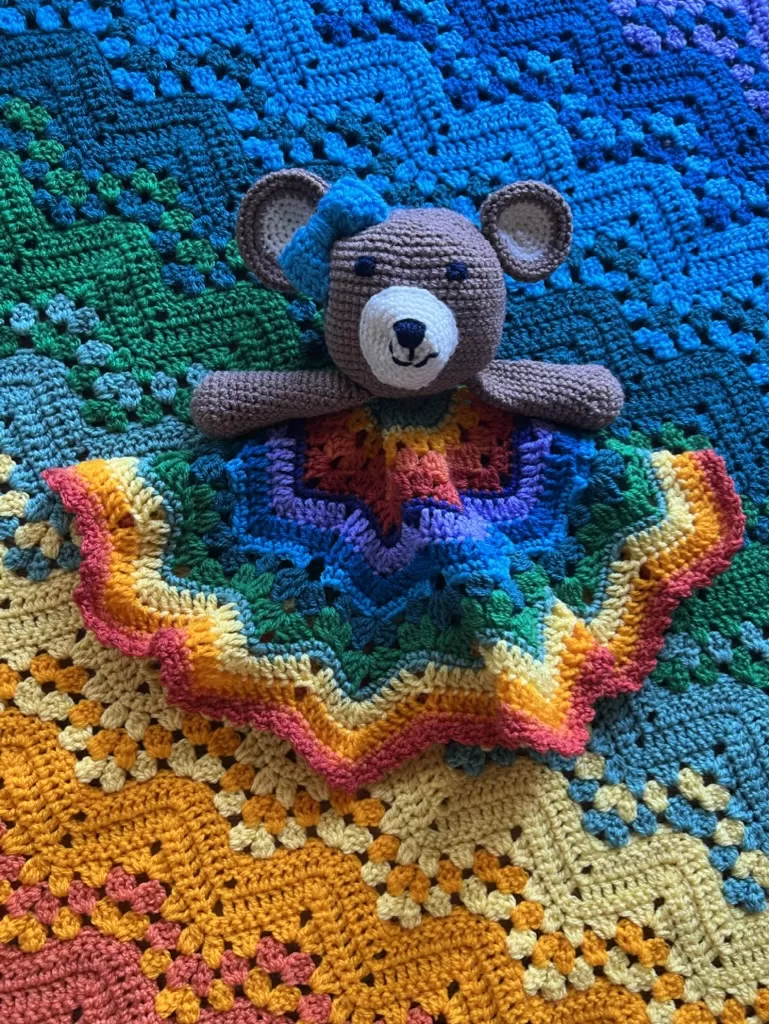
The rainbow stripes are accented by contrasting granny cluster rows and a custom sunshine border finishes off this cheerful blanket.
Matching Lovey by Betty McKnit
Bear Lovey by Courtney Shepherd Gothfaeries Creations
Bundle available HERE
This page contains affiliate links. If you click these links and buy something on the page they take you to, I may, at no additional cost to you, earn a commission. I only affiliate with products and companies I feel good about. Thank you for your support!
Introduction
This blanket is a variation on the classic 6-Day Kid Blanket. It utilizes the striping effect known as Australian Confetti, created by Glynis Robertson, aka Oldboiler Robo. Glynis was inspired by the crochet pattern Confetti Waves designed Kate Rowell.
The rainbow stripes are accented by contrasting granny cluster rows and a custom sunshine border finishes off this cheerful blanket.

Details
US Terminology
Finished Size: 41” x 41” (baby blanket size)
Gauge: 3.5 st/in and 4 rows/in dc
Skill Level: Easy
2000m/2400 yards total DK weight in 11 colors
Shown in: Stylecraft Special DK, Color A: Tomato, Color B: Spice, Color C: Sunshine, Color D: Citron, Color E Sage, Color F Kelly Green, Color G Teal, Color H Turquoise, Color I Empire, Color J Lavender, Color K Lobelia (one ball of each).
Hook: Furls Odyssey G (4 mm) hook
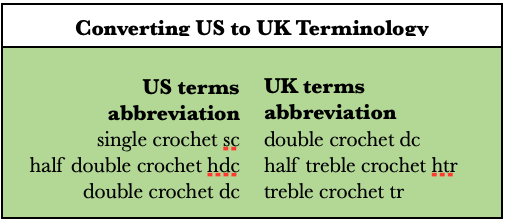
Abbreviations:
ch: chain
dc: double crochet
dc3tog: (this is a cluster and not a decrease. See Special Stitches below).
FPsc: front post single crochet
hdc: half double crochet
rep: repeatsc: single crochetsk: skip
sl st: slip stitchsp(s): space(s)
Special Stitches
dc3tog – worked as a cluster into one stitch – not over three stitches
[yarn over, pull up a loop, pull through two loops] 3 times. Yarn over, and pull through all 4 loops on the hook. (Be sure to pull up a loop in the same stitch every time.) dc3tog complete.
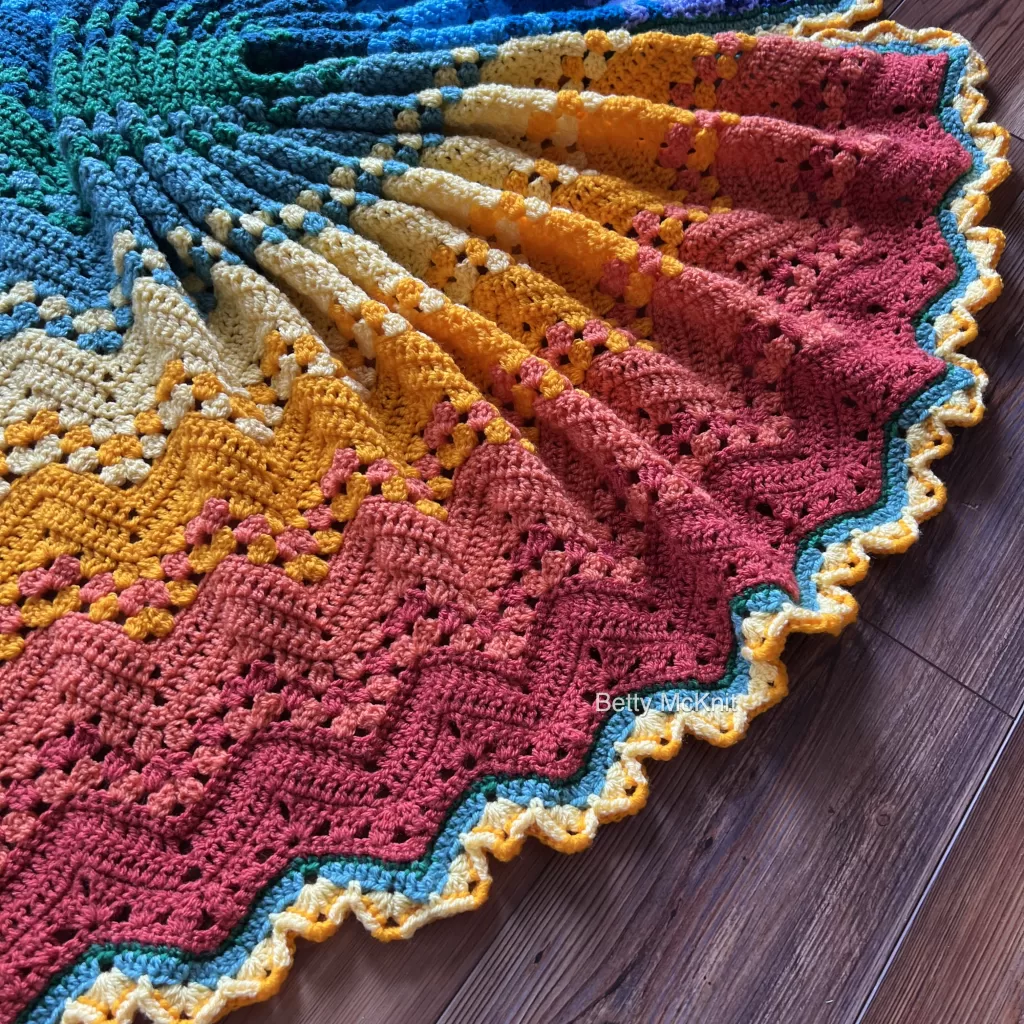
Front Post Stitches
Front post stitches are worked from the front around the post of the stitch in the row below.
Does it really only take 6 Days to make?
The original 6DKB was a toddler sized blanket made with chunky yarn and took me six days of easy crochet – about two hours per day – to make. This variation uses the very similar stitches but uses a different weight yarn. I believe it can be done in six days depending on your skill level and speed, but my advice is to give yourself a couple of extra days.
First timers
If this is your first time making a 6-Day Kid Blanket, before you begin, I strongly suggest you make a swatch while following along with my video tutorials on my YouTube Channel. I know you probably pride yourself on never having swatched and will be tempted to bypass this advice, but take my word for it. The first few rows are a little tricky and you’ll sidestep common mistakes and avoid the frustration of frogging hours of hard work. It doesn’t take that long to swatch along with my tutorials before starting your blanket. Follow the old adage, “To save time, take the time to swatch.”
How to Resize
This pattern creates a baby blanket and no options for resizing are offered in this pattern. If you would like a longer blanket, I suggest you add more colors to your rainbow and work additional stripes. If you would like make this blanket in a different size altogether, please see the the original 6-Day Kid Blanket pattern and my 6DKB Resize Video.

An international community of yarnful makers and friends.
- New pattern pre-releases
- Exclusive patterns never released to the public
- Have access to Betty’s ad-free .pdf library of patterns (3-4 patterns/month)
- Access to Betty’s Design Workshop
- Uplevel your knitting and crochet skills
- Enjoy regular crochet alongs, knit alongs, and classes
- Make like-minded friendships during our weekly social and educational events
- Bonus content every month
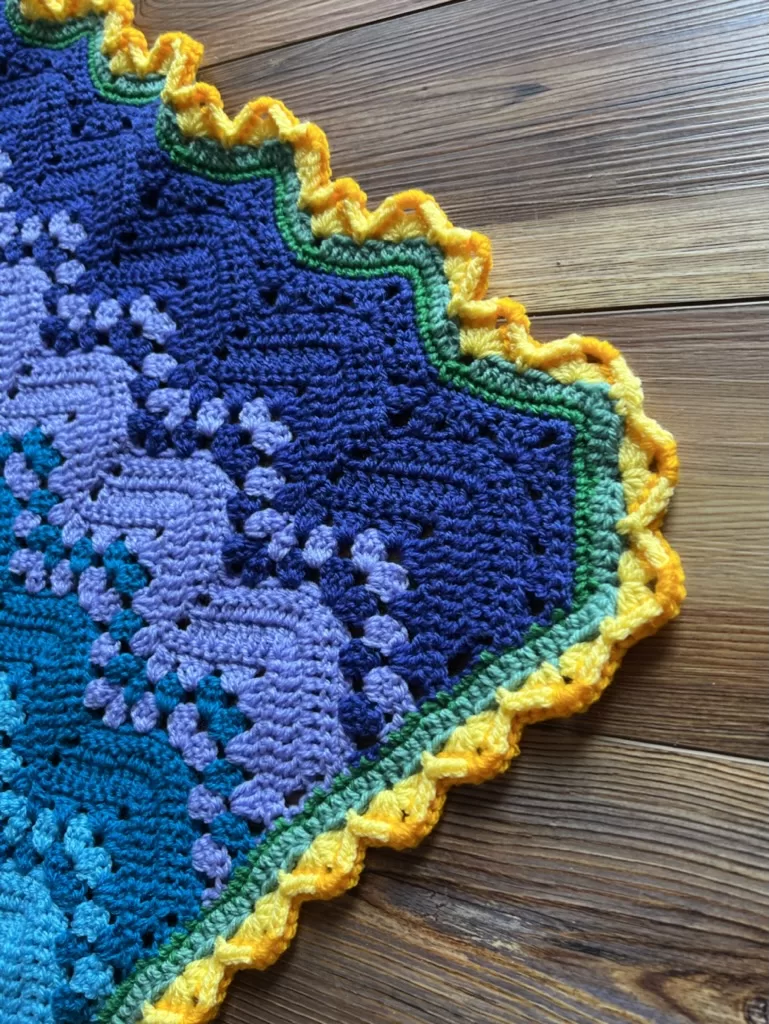
Side edges:
Some crocheters have had issues with the side edges of their blankets curling. Keep in mind that some curling is normal and can be corrected when your border your blanket and wash it. If you find that curling is excessive, here are some steps you can take to help alleviate it. Try them out on your swatch. You will most likely not need all of these options, but a combination of one or more should the trick.
- ch 4 at the beginning of the row where the instructions say to ch 3. This is something you should try in your swatch, as some crocheters with tighter tension find that they really do need that extra stitch. Others do fine without it.
- Replace the dc at the end of row 2 and 3 with extended double crochet (edc).
Keep in mind when adding additional chains or edc on the edge you may need to skip stitches when working along the sides to get your edges to lie flat. There is no exact formula for how many sc to work into the side edges. Use your judgement and lay it down often and check it as you are working.
- When working the last stitch of the row, insert the hook from back to front, instead of from front to back.
- Work an edge into the turning chains and sc/dc stitches on the sides of the work as described at the end of this pattern, rather than into the spaces.
- Wash your blanket once it is complete, and lay it out flat to dry, gently stretching and shaping the edges.
Changing Colors:
The 6-Day Kid Blanket can take on a different appearance depending on the placement of stripes and use of colors. The original 6-Day Kid Blanket was called Vivid Chevrons and other popular stripes are known as the The Snowflake Effect, Viral Stripe, Popsicle Effect, and Ridgy Didge. For more information, please see my article “No Two 6-Day Kid Blankets are Alike.”
This stripe is called the Australian Confetti, and it was conceptualized by Glynis Robertson, aka “Oldboiler Robo.” Glynis was inspired by the crochet pattern Confetti Waves designed Kate Rowell when she first designed her confetti-striped 6DKB.
The Aussie Confetti stripe is created by changing colors after row 7 and adding an additional granny row in the color of the previous stripe for row 3, then repeating row 3 and continuing the repeat with the next color in the sequence.
To change yarn on color changes, draw the new color through the last two loops of the last stitch of the row before the color change.
To Turn or Not to Turn
I have reduced the number of ends by adding new colors at the beginning of the row with the right side facing. That way I can carry the yarn up the side of the work and avoid having four new ends to weave.
If it will bother you to have two right side rows next to one another followed by two wrong side rows next to one another, then you can turn after every row and weave in the additional ends if you like.

When carrying yarn up the sides of the work, take care that your tension is just right – not too tight, not too loose. The yarn should lay along the side edge. Once the blanket is complete, you can work your first round of single crochet over the floats. I recommend weaving in all of the loose ends as only working over cut ends does not secure them.
Square Top and Bottom
This blanket has a chevron start and top edge. If you would like a chevron top and bottom instead, you will need to adapt this pattern using the article on my website, How to Start your 6-Day Kid Blanket with a Straight Edge. Remember that the 6-Day Kid Blanket ends on row 4 (not 7) so plan ahead for your top and bottom to match. See the 6-Day Viral Blanket for more information about stripe symmetry.
About the row numbers:
In order to provide consistency across all of the 6-Day Kid Blanket pattern variations, I’ve numbered the rows to correspond to the original pattern. The cluster rows are always Row or Round 2 and 3, the dc rows are always Row or Round 5 and 6, and the sc rows are always Row or Round 4 and 7.
This stripe creates a change in the regular sequence of the 6DKB. You will be guided to work the rows in the proper order; don’t let the numbers throw you off or overthink a change in the sequence.
Begin
Starting with Color A ch 190 (Multiple of 17+3).

Row 1: starting in second ch from hook, sc across.
Turn
Row 2: ch 3, sk first 3 sc (the sc on the end of the row, the one below your turning chain counts as 1)
(3 dc in next sc, sk next 2 sc) twice, (3 dc, ch 3, 3 dc) into next sc
*sk next 2 sc, 3 dc into next sc, sk next 2 sc, dc3tog, sk next 4 sc, dc3tog, sk next 2 sc, 3 dc in next sc, sk next 2 sc, (3 dc, ch 3, 3 dc) into next sc; rep from * to last 9 sc, sk next 2 sc, (3 dc into next sc, sk next 2 sc) twice, dc in last sc.

Turn
This is one of those times the sequence of the row numbers is off. Proceed to Row 4.
Row 4: ch 1, sc into first dc of the row (the one right below your turning chain)
sk next dc, 1 sc into each of next 8 dc
*3 sc into next ch 3 sp, 1 sc into each of next 14 sts
repeat from * to last ch 3 sp, 3 sc into last ch 3 sp
1 sc into each of next 8 dc, sk next dc, sc into top of turning ch.
Turn
Row 5: Ch 3, sk 2, (the sc your turning chain is coming out of counts as the first one).
1 dc into each of next 8 sc
*3 dc into next sc (you should be working these into the center stitch of the 3 sc. If not, you may have skipped incorrectly in the beginning of the row.) 1 dc into each of next 7 sc
sk next 2 sc, 1 dc into each of next 7 sc
rep from * to last 11 sc, 3 dc into next sc, 1 dc into each of next 8 sc
sk 1, dc in last st.
Turn
Row 6: Ch 3, sk first 2 dc in the row below (the dc below your turning chain counts as 1)
1 dc into each of next 8 dc
*3 dc into next dc (you should be working into center stitch of 3 dc)
1 dc into each of next 7 dc, sk next 2 dc, 1 dc into each of next 7 dc
rep from * to last 10 dc
3 dc into next dc, 1 dc into each of next 8 dc, sk last dc, 1 dc into top of turning ch.
Turn
Row 7: Ch 1, sc into first dc (the same one the turning chain is coming out of), sk 1, sc into each dc along row to last dc, sk last dc, 1 sc into top of turning ch.
Do not turn or fasten off (unless you prefer weaving in additional ends).
With right side of row 7 facing you, attach Color B at the beginning of the row and repeat Row 2.
Turn
Change back to Color A, carrying the yarn up the side of the work.
Row 3: ch 3, sk sp between turning ch and next 3-dc group, 3 dc into each of next 2 sp
[3 dc, ch 3, 3 dc] into next ch-3 sp
*3 dc into next sp, dc3tog into next sp
sk next sp, dc3tog into next sp, 3 dc into next sp, [3dc, ch3, 3dc] into next ch- 3 sp

rep from * to last 3 sps, 3 dc into each of next 2 sps
1 dc into sp between last 3 dc group and turning ch.
Do not turn. Fasten off Color A.
With right side of row 3 facing you, Change to Color B at the beginning of the row and repeat Row 3. Continue in Color B through Row 7.
Turn
Repeat rows 2-7 nine times more. On each repeat you will change to the next color for row 2, change back to the previous color you were using for row 3, change to your new color and repeat row 3, and finish the repeat with the new color.
After Color B the sequence of colors is C, D, E, F, G, H, I, J, and K.
Repeat rows 2 and 4 (skip row 3) in Color K. Fasten off.
Continue to border.
Border
Border Round 1:
Join Color F with sc to top left corner of the blanket. Working down the left side, sc down the side of the blanket. Treating the turning chains and the sc and dc stitches like foundation chains, work sc under 2 threads of each stitch and leave one thread below. This creates a beautiful even edge to the work. The number of sc you will put in each stitch will vary depending on your tension, but a general rule is 2 sc per dc, 2 sc per turning ch, and 1 sc per sc. Lay your work down often to check that your edge is laying flat and adjust the number of stitches accordingly.
Work 3 sc into the corner and continue across the bottom, working into the bottom of your starting chain, and placing 3 sc into the peak and skipping 1 in each valley (this won’t be perfectly even). Add 3 sc to the corner and work up the right side of the blanket as the left, put 3 sc in the corner and work across the top again working 3 sc in peaks and sk 1 in the valleys. Finish with 2 sc in the same sp as the first sc of top edge row 4, join with sl st. Fasten off.

Border Round 2:
Join Color E to any st. Work a round of hdc around the blanket, working 3 hdc in each corner and peak and skipping 1 in each valley. Join with sl st to first hdc. Fasten off.
Border Round 3:
Join Color D with sc to any corner. *sk 2, (3 dc, ch 3, 3 dc) in next st, sk 2, sc in next sp. Repeat from * around, adjusting your skips so that the sc lands on the peaks and corners and a (3 dc, ch 3, 3 dc) lands in the valley, where you can work it into the sp between skipped hdc. Join with sl st to first sc. Fasten off.
Turn
Final Border Round:
Withwrong side of border facing, join Color C with sc in any ch 3 sp. * 3 FPsc, sk 1, 3 FPsc, 3 sc in ch 3 sp, repeat from * around, finishing with 2 sc in first ch 3 sp. Join with sl st to first sc. Fasten off.
Weave in all ends.

Matching Lovey by Betty McKnit
Bear Lovey by Courtney Shepherd Gothfaeries Creations
Bundle available HERE
This page contains affiliate links. If you click these links and buy something on the page they take you to, I may, at no additional cost to you, earn a commission. I only affiliate with products and companies I feel good about. Thank you for your support!
Beth McKee Elliott
aka Betty McKnit
Beth McKee Elliott, also known as Betty McKnit, is a crochet and knitting designer, instructor, community leader, and Master Somatic Movement Therapist and Educator. Her signature style, 6-Day Crochet, is showcased in the viral crochet patterns the 6-Day Kid Blanket and 6-Day Star Blanket.
She specializes in Somatic Crochet and Knitting, a mindfulness practice that combines crochet/knitting with body awareness techniques to prevent injury and promote well-being and creativity in crafting.
In addition to being a crochet designer, Beth is a choreographer. She is the creator and director of Small Plates Choreography Festival, Haven Movement Company, and the Dance Maker Podcast.
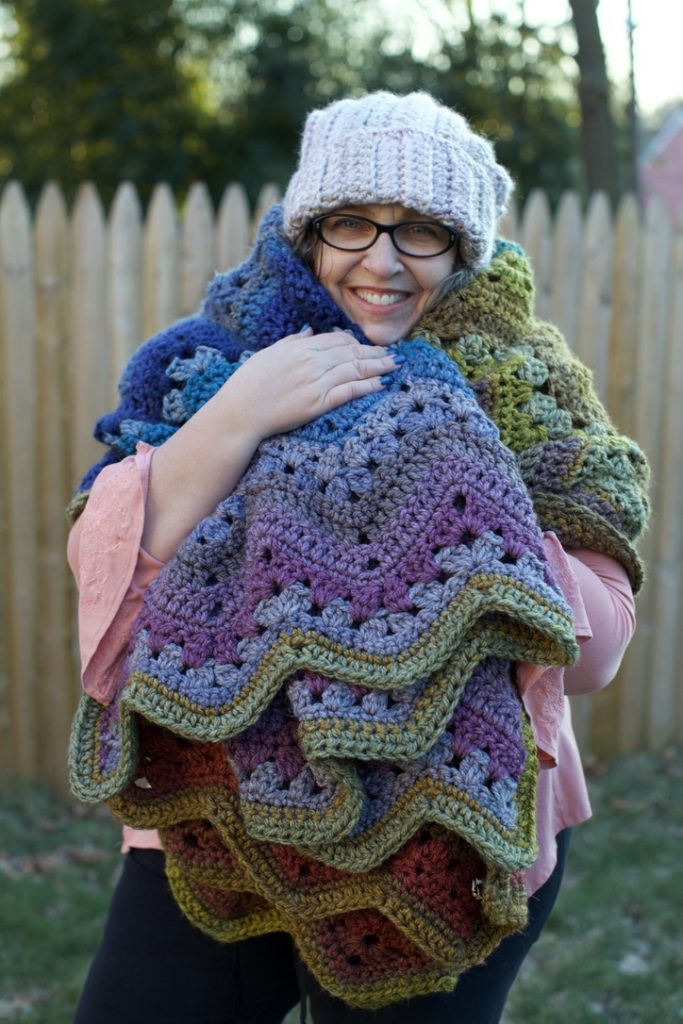
The “Australian Confetti” Stripe was conceptualized by Glynis Robinson and members of the 6-Day Kid Blanket Community. Thank you to our members for their creative contributions to the 6-Day Kid Blanket family of patterns.
Join us in the 6-Day Kid Blanket Facebook Group for help with this pattern and to show off your finished creations. Be sure to tag @bettymcknit in your social media posts
Video tutorials available on my YouTube Channel.
This pattern contains affiliate links. If you click these links and buy something on the page they take you to, I may, at no additional cost to you, earn a commission. I only affiliate with products and companies I feel good about. Thank you for your support!
This pattern is the intellectual property of Betty McKnit/Beth Elliott. This pattern, The 6-Day Kid Blanket, “6DKB” and derivative works are also protected by copyright. Publishing translations, corrections, variations, or tutorials of this pattern, online or elsewhere without written permission from the owner is a violation of copyright.
The stitch pattern is “Vivid Chevrons” #110 from 200 Ripple Stitch Patterns by Jan Eaton.
Reprinted with permission from Quarto Publishing.

